|
SALABHASANA: The Locust Pose
Salabhasana is the ideal exercise to
counteract the effects of sitting for too long slumped over a driving wheel or at a keyboard. Low back
weakness is often the cause of low back aches which many people suffer. The cure is up to you.
Basically the back and abdominal muscles need to be STRONG to support the trunk and our activities. In this asana be aware
of any low back problems. We can do much to help ourself but enduring pain is counterproductive, so expect
to have to work hard here but not strain. As a general rule hold the position only as long as you can breath
comfortably. That may mean going up and down several times, moving with each breath. Lie on your front.
The arms can be by the side of the body in the simple version. Begin by raising one leg at a time
into the air. Try to keep the legs fairly straight. Pressing the arms into the ground
helps. Do not lift your head. After each leg has been used, rest for a couple of breaths
and then repeat, raising both legs together. Make sure that you focus on lifting the thighs and not just
the feet and lower legs from the ground.
| Salabhasana - The Locust |
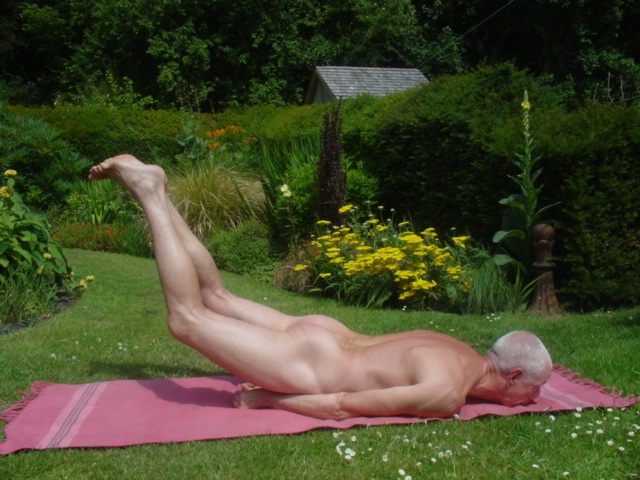
|
In the more advanced
version, lie on your clenched fists in a sort of volleyball player`s position. With
a sharp exhalation kick both legs simultaneously as high as you can into the air pressing down hard with the hands. Eventually you may be able to lift the legs and lower torso into the air.
SIMHASANA - the Lion
| Simhasana - Roaring Lion |
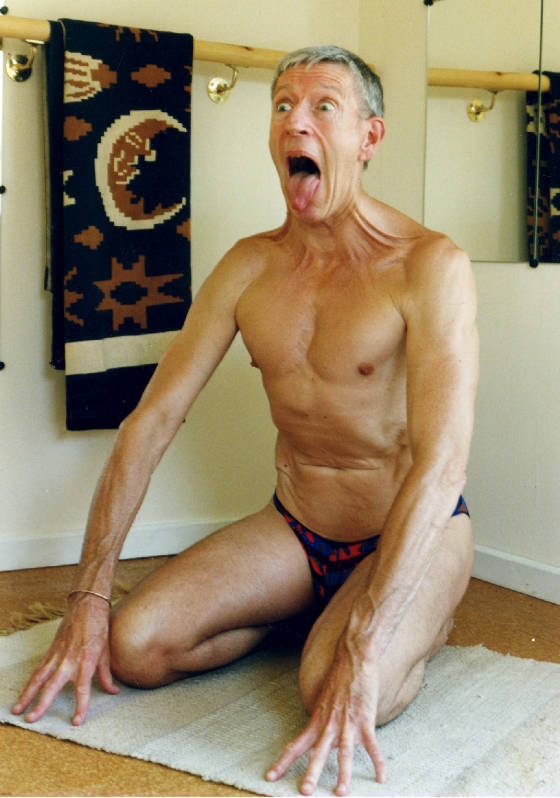
|
Simhasana
is a valuable exercise for we mere mortals who find stress and frustration building up from time to time. Although
called an asana I prefer to think of it as a dynamic exercise and a form of pranayama – a breathing exercise. This
exercise can be performed kneeling as shown, or standing or sitting. I have never tried it lying down! Kneeling
in Vajrasana – sitting on your heels, place the hands on the upper thighs or with arms stretched forwards so the fingers
can be in contact with the earth. Bring to mind any sense of anger, frustration, fear or negativity.
If you are fortunate not to have any personal problems you should think of the situation others may find themselves
in. Your anger can then be directed towards the positive intention of fighting on their behalf. Think
of yourself as a lion guarding your family. Much of the success lions have in this situation is through
bluff. By puffing themselves up, inflating the mane and the chest, they look much bigger. As
they roar or growl it is a serious warning to potential aggressors. They are driving away the threat to
their security. In our creation of the exercise we are driving away inner demons and fears etc.
This is a good example of a yoga position where we may appear to be `looking like a lion`, but where in fact we only
get the real benefits when we `become like a lion` in spirit. Take in a deep breath. Bring into your
chest, shoulders and arms all the tension and stress you are aware of and tighten the muscles as hard as you can.
On a great exhalation shoot those demons down through your arms and out of the hands and fingers; if the fingers are
in contact with the ground they become your lightning conductors as you shoot the negativity into the earth – our mother
who takes on board all our problems! Alternatively, like a cat, extend your arms forwards with fingers
outstretched like talons. In a very unyogic way visualise the effect those talons would have on a foe.
The important thing is to free your body of those negative feelings. At the same time as
you exhale open the mouth wide projecting the tongue forwards so the muscles in the throat are stretched helping to aerate
those muscles and throat tissues. Open the eyes wide to make yourself look fearsome. In
the east the eyes would be turned up inside the forehead to look more awesome. I prefer to look my enemies
in the eye and so stare forwards. Repeat twice more, three times in all. The exhalation
can be performed with a loud satisfying roar, or silently. Some schools advise holding the position silently
for several breaths. Physically the pose benefits the feet, ankles and knees which are stretched.
Muscles of the upper body and face are toned and strengthened. The lungs are emptied
as much as possible of stale air. The throat muscles are also toned and given an extra supply of fresh
blood. It is said the exercise protects against sore throats (If you have a sore throat
use the silent version) and gives the yogi a rich and melodious voice – a useful asana before bhajan
or mantra chanting. Derek Osborn 2006
SIRSASANA - Headstand
| Sirsasana 1 start of headstand |

|
| Sirsasana 2 |
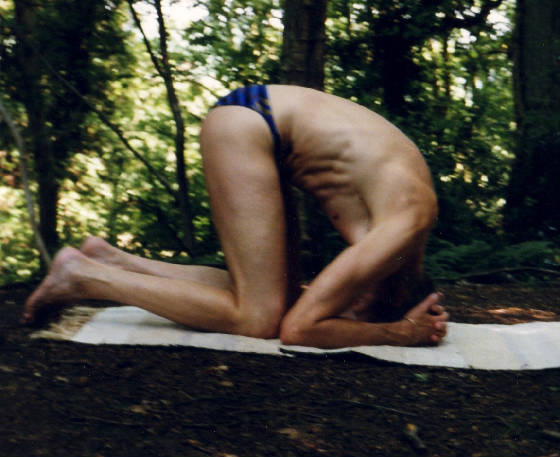
|
| Transferring the weight forwards. |
| Sirsasana 3 |
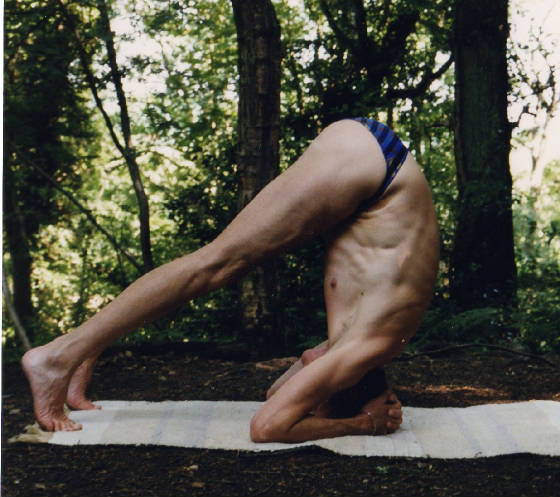
|
| The centre of gravity moves through the spine. |
| Sirsasana 4 |
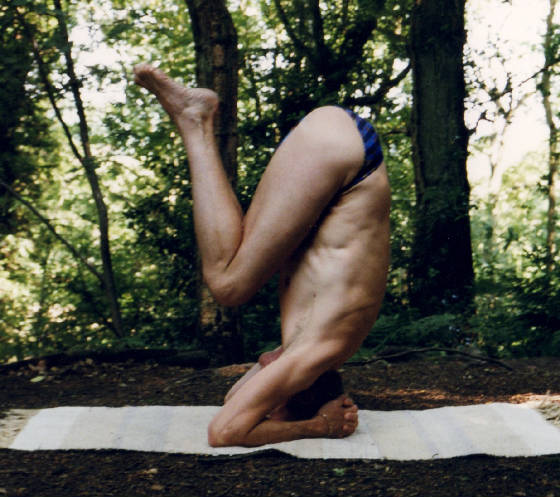
|
| Sirsasana 5 |
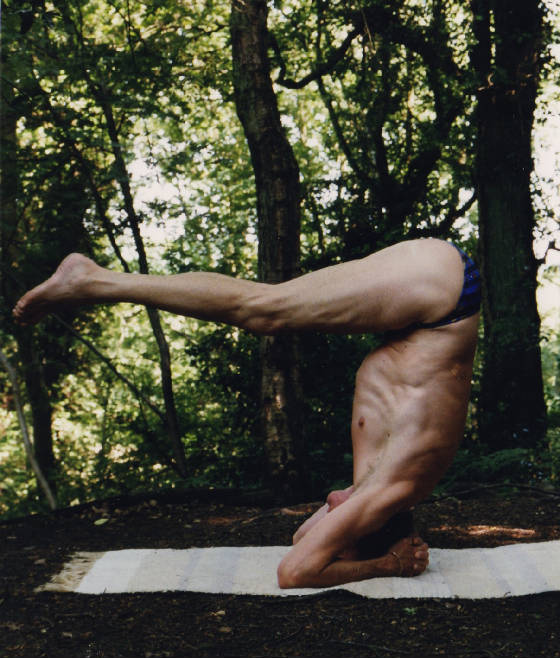
|
| Sirsasana 6 |
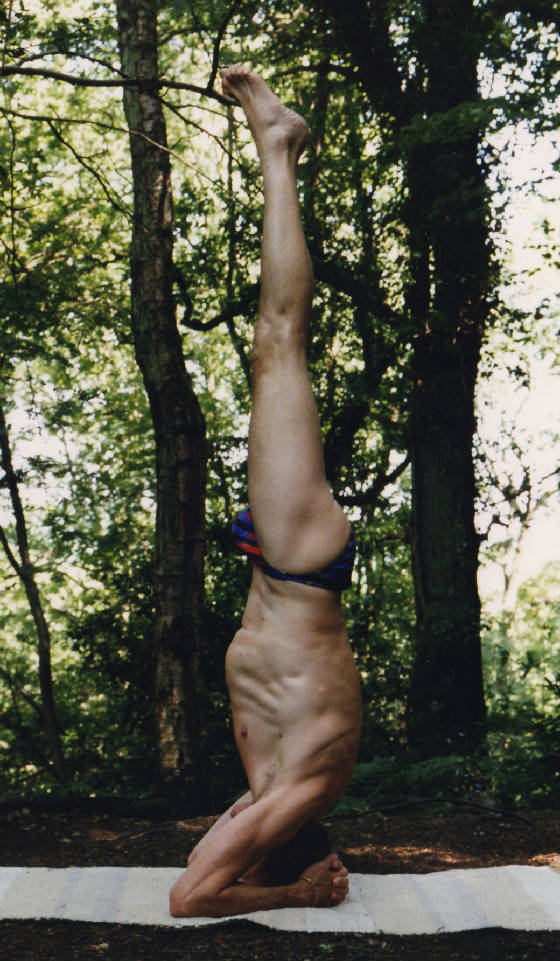
|
| How NOT to do it. |
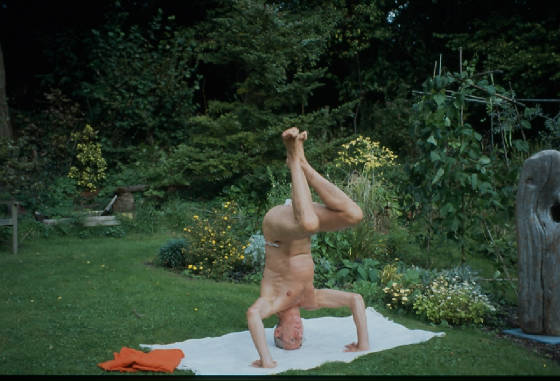
|
SURYA NAMASKAR - The
Salute to the Sun
This
must surely be the most well known and used sequence of exercise used in yoga. Almost every school of Hatha
yoga has its own version of this salute. However although the variations are endless, the basic sequence
is constant. Following is my own `take` on the exercise and its meanings. Stand in Tadasana. The sequence
begins with acknowledging the sun as Surya – the Sun deity, the symbol of the Divine light and energy which fills us
all on this planet. Facing the rising sun (if possible, if not, imagine that you are), make a wide circle
with the arms, reaching towards the light and cupping it to bring its warmth into your heart as the palms come together, thumbs
lightly touching the heart centre. This position is known as Anjali Mudra. Focus on Anahata chakra.
| Suryanamaskar 1 |
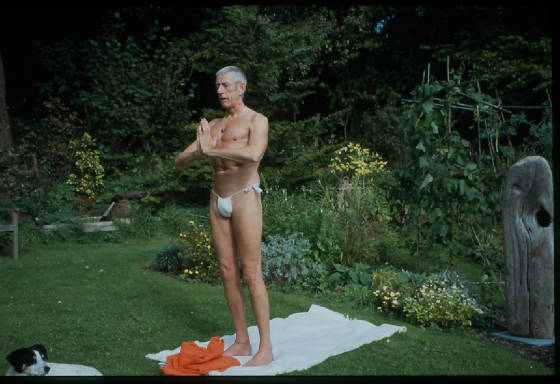
|
2. Opening the elbows wide and extending the arms, bend
the knees slightly, push the hips forwards and arch back looking up to the sky. The throat opens as you
focus on Vishuddha chakra.
| Surya 2 |
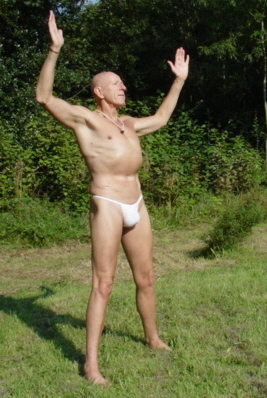
|
3. Folding from the hips bend forwards. Keep
the legs straight as long as possible and then bend them to place the palms of the hands on the ground by the feet.
In this position focus on Svadhistana chakra.
| Suryanamaskar 3 |
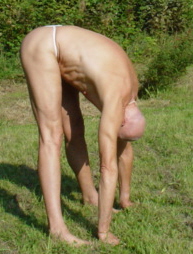
|
4 Step the right foot back keeping the hips down.
Lift the head to look forward and try to pull the chest forwards and between the arms. Feel a sense
of stretch in the abdomen and an opening in the hips and groin. Develop awareness of the Third Eye –
Ajna chakra.
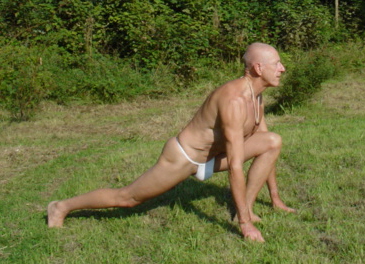
5 Without lifting the hips stride back with the left
leg to create a flat downward facing bridge. Held for a while you will soon feel the powerful strengthening
of the abdomen and middle of the body.
| Surya 5 |
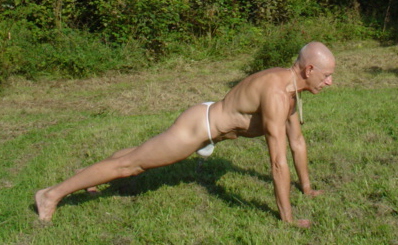
|
6 Push up and back into the Downward Facing Dog pose
– Adho Mukha Svanasana. In this postion feel the back and arms lengthen. Here
the lowest of the chakras – Muladhara, is in the highest position of the body. Meditate on this –
maybe not now! but later.
| Surya 6 |
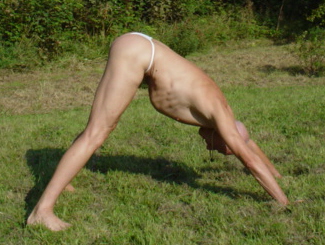
|
7 Lower the knees, chest and chin to the ground into
the Eight Point Touch (see the detailed notes on this asnana). To lower the body flat to the ground some
people may prefer to take the hips back, almost to touching the heels and then to slide the nose and chest forwards close
to the ground, keeping the elbows raised and out to the side. With the navel raised from the ground focus
on Manipura chakra.
8 For those who find it difficult to lift the body just
by pressing downwards, push down and into the centre with the hands as though you were pressing into the sides of a large
Swiss Exercise ball to lift the upper body Breath in as you rise and out as you lower. Focus
on the highest chakra in the body – Sahasrara chakra.
| Surya 8 |
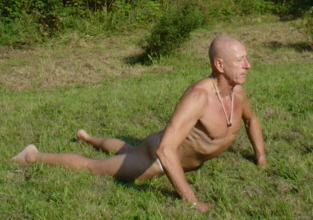
|
--- and return by reversing the sequence. For each repetition
alternate the leading leg. Derek Osborn
2006 03
|